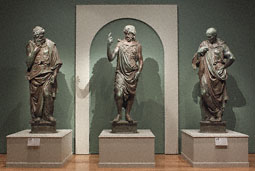|
Leonardo da Vinci (Italian, 1452–1519) was a painter, sculptor, architect, engineer (military, civil, and aeronautical), inventor, anatomist, cartographer, theoretician, and musician. His instinctive curiosity led him to numerous discoveries and achievements, some of which we are still only beginning to comprehend from the thousands of pages of his surviving handwritten notes and drawings.
This focused exhibition examines just one facet of his prodigious talents: his activity in the field of sculpture. Ambitious and detailed plans for enormous equestrian monuments, which were never realized, can only be understood through his drawings. These fragile records are made even more precious by the fact that no work of sculpture can be definitively attributed to Leonardo.
Famous and breathtaking sculptures by Donatello (Italian, about 1386–1466), Leonardo's inspiration, and his close associate Giovan Francesco Rustici (Italian, 1474–1554)—some of which have never left Florence—convey a sense of Leonardo's astounding achievements.
|
|
The exhibition examines many of Leonardo's drawings, highlighting his working method of sketching ideas and notes for his artistic compositions and devices, which do not survive. Sketches for lost sculptures and paintings reveal an artist who used pen and paper to develop models for equestrian and human monuments and sculptures, medals and paintings, as well as to work out the engineering of mechanical devices such as water clocks, robots, and automata.
In sketches for a painting (now lost) in the image at left, Leonardo studied the playful interaction of a child with a lamb, turning the figures around in his mind. His first sketches were in black chalk (also visible), and he worked some of these up to different degrees in ink as he searched for the most satisfactory solution. The emphasis on three-dimensionality parallels Leonardo's habit of making small wax models of groups to visualize them from numerous angles.
 Audio: Leonardo's drawings give insight into his sculptural thinking. Audio: Leonardo's drawings give insight into his sculptural thinking.
|
 |

 |
 |
John the Baptist Preaching to a Pharisee and a Levite, 1506–11, Giovan Francesco Rustici.
Museo dell'Opera del Duomo, Florence. Courtesy the Opera di Santa Maria del Fiore, Florence. Photo: Mike Jensen, 2009
|
 |
The exhibition also features three larger-than-life-size bronze figures by Giovan Francesco Rustici, recently restored in Florence and never before seen outside Italy. Leonardo and Rustici worked closely together, and Rustici was immersed in Leonardo's studio practice. Because of their collaborations and similar aesthetic, Rustici's work is considered the best echo of Leonardo's lost activity as a sculptor.
The handling of the three elegant and lively figures, the variety of their drapery, and their anatomical realism give credence to an opinion related by Giorgio Vasari that "Leonardo worked at the group with his own hand, or that he at the least assisted Rustici with counsel and good judgment."
In the absence of any securely attributed sculptures by Leonardo himself, these works, along with his surviving drawings, give us a glimpse of Leonardo's sculptural accomplishments.
|
|

Leonardo da Vinci and the Art of Sculpture: Inspiration and Invention is organized by the High Museum of Art, Atlanta in association with the J. Paul Getty Museum, Los Angeles. The exhibition is supported by an indemnity from the Federal Council on the Arts and Humanities. The J. Paul Getty Museum is also grateful for the support of the Istituto Italiano di Cultura and the Italian Consulate General, Los Angeles.
|